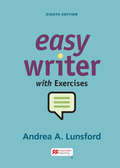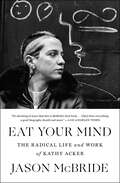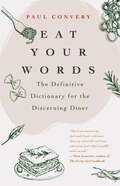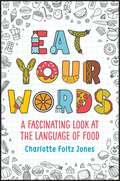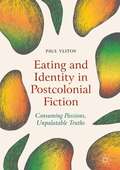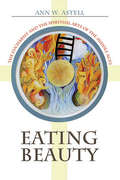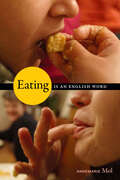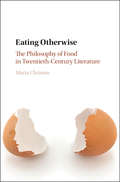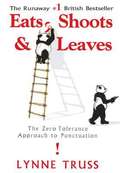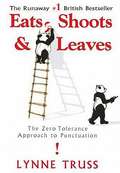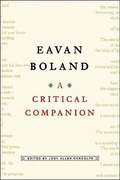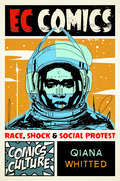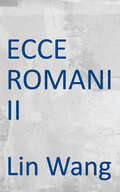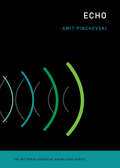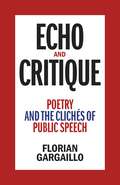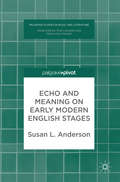- Table View
- List View
EasyWriter with Exercises
by Andrea A. LunsfordWith coverage of critical reading and writing skills, EasyWriter with Exercises empowers you to make effective writing choices for all your writing situations. It’s easy to use and easy to afford!
Eat and Be Eaten: How an Ecologist Uses Food Webs (SEEDS Book Reader)
by Jonathan CurleyNIMAC-sourced textbook
Eat Your Mind: The Radical Life and Work of Kathy Acker
by Jason McBrideThe first full-scale authorized biography of the pioneering experimental novelist Kathy Acker, one of the most original and controversial figures in 20th-century American literature.Kathy Acker (1947–1997) was a rare and almost inconceivable thing: a celebrity experimental writer. Twenty-five years after her death, she remains one of the most original, shocking, and controversial artists of her era. The author of visionary, transgressive novels like Blood and Guts in High School; Empire of the Senses; and Pussy, King of Pirates, Acker wrote obsessively about the treachery of love, the limitations of language, and the possibility of revolution. She was notorious for her methods—collaging together texts stolen from other writers with her own diaries, sexual fantasies, and blunt political critiques—as well as her appearance. With her punkish hairstyles, tattoos, and couture outfits she looked like no other writer before or after. Her work was exceptionally prescient, taking up complicated conversations about gender, sex, capitalism, and colonialism that continue today. Acker&’s life was as unruly and radical as her writing. Raised in a privileged but oppressive Upper East Side Jewish family, she turned her back on that world as soon as she could, seeking a life of romantic and intellectual adventure that led her to, and through, many of the most thrilling avant-garde and countercultural moments in America: the births of conceptual art and experimental music; the poetry wars of the 60s and 70s; the mainstreaming of hardcore porn; No Wave cinema and New Narrative writing; Riot grrls, biker chicks, cyberpunks. As this definitive biography shows, Acker was not just a singular writer, she was also a titanic cultural force who tied together disparate movements in literature, art, music, theatre, and film. A feat of literary biography, Eat Your Mind is the first full-scale, authorized life of Acker. Drawing on exclusive interviews with hundreds of Acker&’s intimates as well as her private journals, correspondence, and early drafts of her work, acclaimed journalist and critic Jason McBride offers a thrilling account and a long overdue reassessment of a misunderstood genius and revolutionary artist.
Eat Your Words: The Definitive Dictionary for the Discerning Diner
by Paul Convery“An outstanding contribution to the field of food language and lore and an accessible reference book for professional and amateur foodies alike.” —Susannah Seton, author of Simple Pleasures of the KitchenEat Your Words is a gloriously gluttonous glossary of all things grub and gastronomy: It’s a true treat for anyone who loves language as much as they love food. With witty and fun definitions of everything from aeroponics to zoosaprophagy, this compilation offers definitions of six thousand unusual and unfamiliar terms across twenty-one fact-packed courses.For bon viveurs and verbivores alike: Are you a gourmet who knows the difference between Maldon and Morton salt? Maybe you’re an expert on the properties of heat in cooking. Or you’re a cocktail connoisseur with a taste for tequila. Eat Your Words is a surprising treat for anyone who loves learning about food and cooking.A delight for word nerds: For Scrabble stars and anyone who excels at Words with Friends, Eat Your Words is a clever guide to little-known culinary terms that will give you that special edge.In Eat Your Words, you’ll find terms about:A cornucopia of culinary treats from around the worldThe cultivation, selling, and serving of every food you can imagineThe appetites of diners and their dinners across all speciesThis new dictionary is the fun reference book you didn’t know you wanted. Fans of Tequila Mockingbird and On Food and Cooking will enjoy this fascinating journey into the language of food and eating.“Now I can impress my food-snob friends with more than my ratatouille and learn some great food-related Scrabble words as well.” —Nina Lesowitz, author of The Party Girl Cookbook
Eat Your Words: A Fascinating Look At The Language Of Food
by Charlotte Foltz Jones John O'BrienBaked Alaska, melba toast, hush puppies, and coconuts. You'd be surprised at how these food names came to be. And have you ever wondered why we use the expression "selling like hotcakes"? Or how about "spill the beans"? There are many fascinating and funny stories about the language of food--and the food hidden in our language! Charlotte Foltz Jones has compiled a feast of her favorite anecdotes, and John O'Brien's delightfully pun-filled drawings provide the dessert. Bon appetit!
Eating and Ethics in Shakespeare's England
by David B. GoldsteinDavid B. Goldstein argues for a new understanding of Renaissance England from the perspective of communal eating. Rather than focus on traditional models of interiority, choice and consumption, Goldstein demonstrates that eating offered a central paradigm for the ethics of community formation. The book examines how sharing food helps build, demarcate and destroy relationships – between eater and eaten, between self and other, and among different groups. Tracing these eating relations from 1547 to 1680 – through Shakespeare, Milton, religious writers and recipe book authors – Goldstein shows that to think about eating was to engage in complex reflections about the body's role in society. In the process, he radically rethinks the communal importance of the Protestant Eucharist. Combining historicist literary analysis with insights from social science and philosophy, the book's arguments reverberate well beyond the Renaissance. Ultimately, Eating and Ethics in Shakespeare's England forces us to rethink our own relationship to food.
Eating and Identity in Postcolonial Fiction: Consuming Passions, Unpalatable Truths
by Paul VlitosThis book focuses on the fiction of four postcolonial authors: V.S. Naipaul, Anita Desai, Timothy Mo and Salman Rushdie. It argues that meals in their novels act as sites where the relationships between the individual subject and the social identities of race, class and gender are enacted. Drawing upon a variety of academic fields and disciplines — including postcolonial theory, historical research, food studies and recent attempts to rethink the concept of world literature — it dedicates a chapter to each author, tracing the literary, cultural and historical contexts in which their texts are located and exploring the ways in which food and the act of eating acquire meanings and how those meanings might clash, collide and be disputed. Not only does this book offer suggestive new readings of the work of its four key authors, but it challenges the reader to consider the significance of food in postcolonial fiction more generally.
Eating Beauty: The Eucharist and the Spiritual Arts of the Middle Ages
by Ann W. Astell"The enigmatic link between the natural and artistic beauty that is to be contemplated but not eaten, on the one hand, and the eucharistic beauty that is both seen (with the eyes of faith) and eaten, on the other, intrigues me and inspires this book. One cannot ask theo-aesthetic questions about the Eucharist without engaging fundamental questions about the relationship between beauty, art (broadly defined), and eating."—from Eating BeautyIn a remarkable book that is at once learned, startlingly original, and highly personal, Ann W. Astell explores the ambiguity of the phrase "eating beauty." The phrase evokes the destruction of beauty, the devouring mouth of the grave, the mouth of hell. To eat beauty is to destroy it. Yet in the case of the Eucharist the person of faith who eats the Host is transformed into beauty itself, literally incorporated into Christ. In this sense, Astell explains, the Eucharist was "productive of an entire 'way' of life, a virtuous life-form, an artwork, with Christ himself as the principal artist." The Eucharist established for the people of the Middle Ages distinctive schools of sanctity—Cistercian, Franciscan, Dominican, and Ignatian—whose members were united by the eucharistic sacrament that they received.Reading the lives of the saints not primarily as historical documents but as iconic expressions of original artworks fashioned by the eucharistic Christ, Astell puts the "faceless" Host in a dynamic relationship with these icons. With the advent of each new spirituality, the Christian idea of beauty expanded to include, first, the marred beauty of the saint and, finally, that of the church torn by division—an anti-aesthetic beauty embracing process, suffering, deformity, and disappearance, as well as the radiant lightness of the resurrected body. This astonishing work of intellectual and religious history is illustrated with telling artistic examples ranging from medieval manuscript illuminations to sculptures by Michelangelo and paintings by Salvador Dalí. Astell puts the lives of medieval saints in conversation with modern philosophers as disparate as Simone Weil and G. W. F. Hegel.
Eating Is an English Word
by Annemarie MolEating is generally understood as a human need that people satisfy in diverse ways. Eating, however, is also an English word. Other languages, using other words, order reality differently: they may fuse eating with breathing, or distinguish chupar from comer. Anthropologists flag such differences by leaving a few of their words untranslated, but what language do we think in? This isn’t necessarily English. We may be linguistically closer to those whose practices we study: them. Against this background, Eating Is an English Word argues that social scientists should let go of the dream of universal concepts. Our analytical terms had better vary. Annemarie Mol and her coauthors exemplify this in a series of material semiotic inquiries into eating practices. They employ terms like lekker, tasting with fingers, chupar, schmecka, gustar, and settling on an okay meal to explore appreciative modes of valuing. Welcome, then, to spirited stories about satisfied stomachs, love for a lamb, juicy fruit treats, and companionable lunches and dinners.
Eating Otherwise: The Philosophy of Food in Twentieth-Century Literature
by Maria ChristouThis book explores the philosophical implications of the popular adage that 'you are what you eat' through twentieth-century literature. It investigates the connections between the alimentary and the ontological: between what or how one eats and what one is. Maria Christou's focus is on two influential modernist figures, Georges Bataille and Samuel Beckett; and two influential postmodernist figures, Paul Auster and Margaret Atwood. She aims to theorize the relationship between modernism and postmodernism from a specifically alimentary perspective. By examining the work of these major twentieth-century authors, this book focuses on strange or unusual acts of eating - 'eating' otherwise - as a means to ways of 'being' otherwise. What can eating tell us about being, about who we are and about our being in the world? This powerful, innovative study takes literary food studies in a new direction.
Eating the Alphabet: Fruits & Vegetables from A to Z
by Lois EhlertA vibrant and sturdy word book starring fruits and vegetables from around the world from Caldecott Honor–winning author-illustrator Lois Ehlert. Features upper- and lowercase letters for preschoolers just learning language.Each turn of the page reveals a mouth-watering arrangement of foods: Indian corn, jalapeno, jicama, kumquat, kiwifruit and kohlrabi. Lois Ehlert's lively watercolors paired with bold easy-to-read type make for a highly appealing and accessible book for parents and children to devour.At the end of the book, Ehlert provides a detailed glossary that includes pronunciation, botanical information, the origin and history of the particular plant and occasional mythological references, with a small watercolor picture to remind the reader of what the plant looks like.Apple to Zucchini,come take a look.Start eating your waythrough this alphabet book.
Eating the Alphabet Fruits and Vegetables from A to Z
by Lois EhlertAn alphabetical tour of the world of fruits and vegetables, from apricot and artichoke to yam and zucchini, including descriptions of 75 fruits and vegetables.
Eats, Shoots and Leaves: The Zero Tolerance Approach to Punctuation
by Lynne TrussEnglish spelling, punctuation, and grammatical terms, (e.g., "stop" for our "period") are deliberately retained in this U.S. edition, as the publisher states in his Note. Chapters on present and former use of the comma, apostrophe, colon, semicolon, dash, ellipses, other punctuation marks presented with humor. You'll laugh and be entertained as well as edified. People who read by listening will have a problem because the words will sound the same whether they are spelled nd punctuated correctly or not, e.g., d o n apostrophe t or d o n t. You may need to have punctuation spoken, at least for the chapter on the apostrophe, or have someone read to you and explain.
Eats, Shoots & Leaves: The Zero Tolerance Approach to Punctuation
by Lynne TrussAnxious about the apostrophe? Confused by the comma? Stumped by the semicolon? Join Lynne Truss on a hilarious tour through the rules of punctuation that is sure to sort the dashes from the hyphens. We all had the basic rules of punctuation drilled into us at school, but punctuation pedants have good reason to suspect they never sank in. 'Its Summer!' screams a sign that sets our teeth on edge. 'Pansy's ready', we learn to our considerable interest ('Is she?') as we browse among the bedding plants. It is not only the rules of punctuation that have come under attack but also a sense of why they matter. In this runaway bestseller, Lynne Truss takes the fight to emoticons and greengrocers' apostrophes with a war cry of 'Sticklers unite!'
Eavan Boland: A Critical Companion
by Jody Allen Randolph Eavan BolandA San Francisco Chronicle Best Book: a celebrated collection from "one of the finest and boldest poets of the last half century" ( Poetry Review ). These are poems about the charged spaces in which people live, about the interiors where seductions, quarrels, memories, and griefs occur. A marriage is a window for outward violence; a painted cup becomes a theater for a long love; in an ordinary room a mythic violation takes place.
EC Comics: Race, Shock, and Social Protest (Comics Culture)
by Qiana WhittedEntertaining Comics Group (EC Comics) is perhaps best-known today for lurid horror comics like Tales from the Crypt and for a publication that long outlived the company’s other titles, Mad magazine. But during its heyday in the early 1950s, EC was also an early innovator in another genre of comics: the so-called “preachies,” socially conscious stories that boldly challenged the conservatism and conformity of Eisenhower-era America. EC Comics examines a selection of these works—sensationally-titled comics such as “Hate!,” “The Guilty!,” and “Judgment Day!”—and explores how they grappled with the civil rights struggle, antisemitism, and other forms of prejudice in America. Putting these socially aware stories into conversation with EC’s better-known horror stories, Qiana Whitted discovers surprising similarities between their narrative, aesthetic, and marketing strategies. She also recounts the controversy that these stories inspired and the central role they played in congressional hearings about offensive content in comics. The first serious critical study of EC’s social issues comics, this book will give readers a greater appreciation of their legacy. They not only served to inspire future comics creators, but also introduced a generation of young readers to provocative ideas and progressive ideals that pointed the way to a better America.
ECCE Romani 2: A Latin Reading Program
by Lin Wangcontains Chapters 28 through 54 of the storyline, plus outstanding support for Word Study, Roman Life, Frontier Life, History, and Mythology
Ecco! Uno Textbook
by Michael Sedunary Nancy Posterino Sophie Kearns Marisa Tarascio-SpillerNIMAC-sourced textbook
Echo (The MIT Press Essential Knowledge series)
by Amit PinchevskiAn exploration of echo not as simple repetition but as an agent of creative possibilities.In this volume in the MIT Press Essential Knowledge series, Amit Pinchevski proposes that echo is not simple repetition and the reproduction of sameness but an agent of change and a source of creation and creativity. Pinchevski views echo as a medium, connecting and mediating across and between disparate domains. He reminds us that the mythological Echo, sentenced by Juno to repeat the last words of others, found a way to make repetition expressive. So too does echo introduce variation into sameness, mediating between self and other, inside and outside, known and unknown, near and far. Echo has the potential to bring back something unexpected, either more or less than what was sent. Pinchevski distinguishes echo from the closely related but sometimes conflated reflection, reverberation, and resonance; considers echolalia as an active, reactive, and creative vocalic force, the launching pad of speech; and explores echo as a rhetorical device, steering between appropriation and response while always maintaining relation. He examines the trope of echo chamber and both destructive and constructive echoing; describes various echo techniques and how echo can serve practical purposes from echolocation in bats and submarines to architecture and sound recording; explores echo as a link to the past, both literally and metaphorically; and considers echo as medium using Marshall McLuhan&’s tetrad.
Echo and Critique: Poetry and the Clichés of Public Speech
by Florian GargailloIn Echo and Critique, Florian Gargaillo skillfully charts the ways that poets have responded to the clichés of public speech from the start of the Second World War to the present. Beginning around 1939, many public intellectuals on both sides of the Atlantic lamented that the political lexicon had become saturated with bureaucratic stock phrases such as “the fight for freedom,” “revenue enhancement,” and “service the target,” designed for the mass media and used to euphemize, obfuscate, and evade. Instead of ridding their writing of such language, many poets parroted these tropes as a means of exploring the implications of such expressions, weighing their effects, and identifying the realities they distort and suppress. With its attentiveness to linguistic particulars, poetry proved especially well-suited to this innovative mode of close listening and intertextual commentary. At the same time, postwar poets recognized their own susceptibility to dead language, so that co-opting political clichés obliged them to scrutinize their writing and accept the inevitability of cant while simultaneously pushing against it.This innovative study blends close readings with historical context as it traces the development of echo and critique in the work of seven poets who expertly deployed the method throughout their careers: W. H. Auden, Randall Jarrell, Langston Hughes, Claude McKay, Robert Lowell, Josephine Miles, and Seamus Heaney. Gargaillo’s analysis reveals that poetry can encourage us to listen diligently and critically to the insincerity ubiquitous in public discourse.
Echo and Meaning on Early Modern English Stages
by Susan L. AndersonThis book examines the trope of echo in early modern literature and drama, exploring the musical, sonic, and verbal effects generated by forms of repetition on stage and in print. Focusing on examples where Echo herself appears as a character, this study shows how echoic techniques permeated literary, dramatic, and musical performance in the period, and puts forward echo as a model for engaging with sounds and texts from the past. Starting with sixteenth century translations of myths of Echo from Ovid and Longus, the book moves through the uses of echo in Elizabethan progress entertainments, commercial and court drama, Jacobean court masques, and prose romance. It places the work of well-known dramatists, such as Ben Jonson and John Webster, in the context of broader cultures of performance. The book will be of interest to scholars and students of early modern drama, music, and dance.
An Echo in the Mountains: Al Purdy after a Century
by Nicholas BradleyFrom the 1960s until his death in 2000, Al Purdy was one of the most prominent writers in Canada, famous for his frank language and his boisterous personality. He travelled the country and wrote about its people and places from Newfoundland to Vancouver Island. A central figure in the CanLit explosion of the sixties and seventies, Purdy has been called the best, the most, and the last Canadian poet. But Purdy's Canada no longer exists. A changing country and shifting attitudes toward Canadian literature demand new perspectives on Purdy's impact and accomplishments. An Echo in the Mountains reassesses Purdy's works, the shape of his career, and his literary legacy, grappling with the question of how to read Purdy today, a century after his birth and in a new era of Canadian literature. Contributors to the volume examine Purdy's critical reception, explore little-known documents and textual problems, and analyze his representations of Canadian history and Indigenous peoples and cultures. They show that much remains to be discovered and understood about the poet and his immense body of work.The first sustained examination of Al Purdy's works in over a decade, An Echo in the Mountains showcases the critical challenges and rewards of rereading an iconic and influential Canadian writer.
Echoes of a Queer Messianic: From Frankenstein to Brokeback Mountain (SUNY series, Literature . . . in Theory)
by Richard O. BlockQueer theory has focused heavily on North American and contemporary contexts, but in this book Richard O. Block helps to expand that reach. Deftly combining the two main currents of recent queer theory, the asocial and the reparative, he reconsiders mostly German narratives from around 1800, while relating his findings to recent texts such as A Lover's Discourse and Brokeback Mountain. He offers novel readings of well-known texts by Shelley, Kleist, and Goethe, arguing that this early writing serves as a creative font for much of the subsequent work in sexology. These texts also provide echoes of a kind of love overlooked or suppressed in favor of a politics of appeasement or one intended to make queers model citizens. This book charts the unexplored possibilities for queer love in an attempt to map a future for gay politics in the age of homonormativity.
Echoes of Desire: English Petrarchism and Its Counterdiscourses
by Heather DubrowEchoes of Desire variously invokes and interrogates a number of historicist and feminist premises about Tudor and Stuart literature by examining the connections between the anti-Petrarchan tradition and mainstream Petrarchan poetry. It also addresses some of the broader implications of contemporary critical methodologies. Heather Dubrow offers an alternative to the two predominant models used in previous treatments of Petrarchism: the all-powerful poet and silenced mistress on the one hand and the poet as subservient patron on the other.
